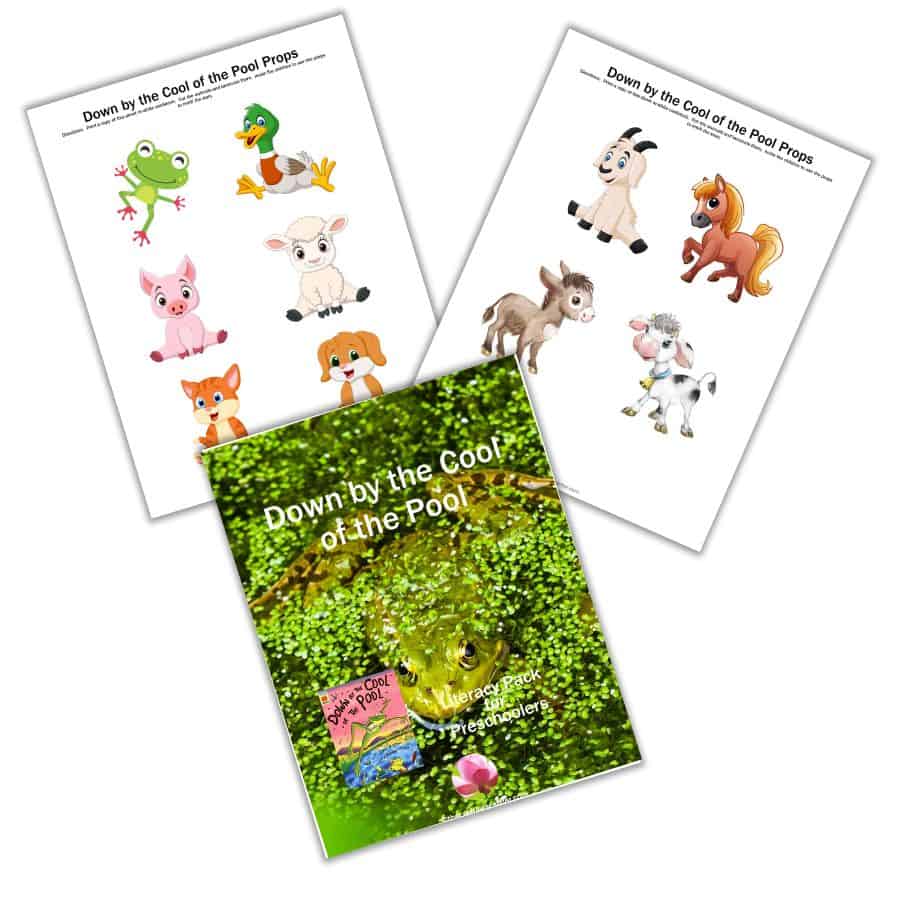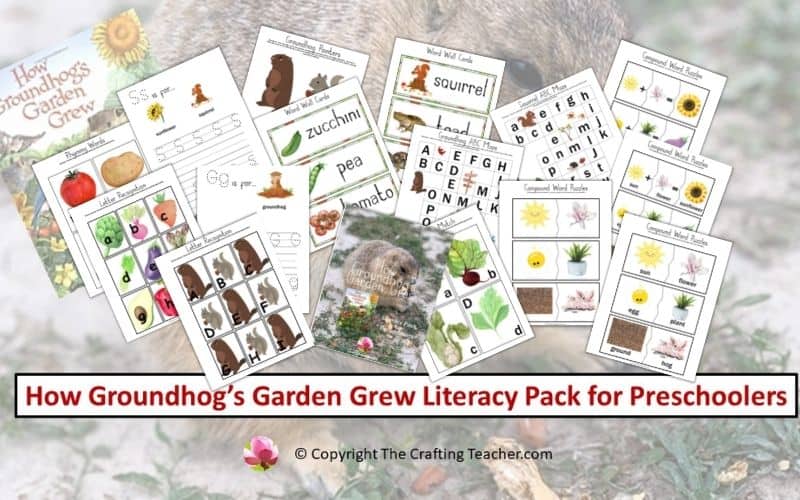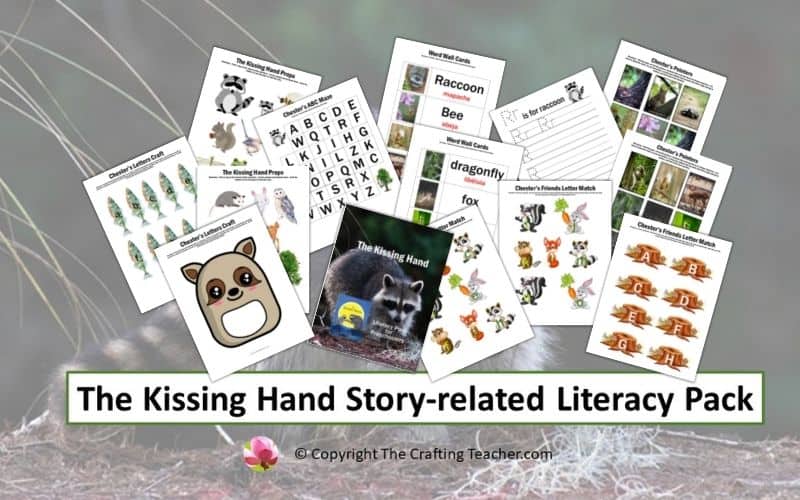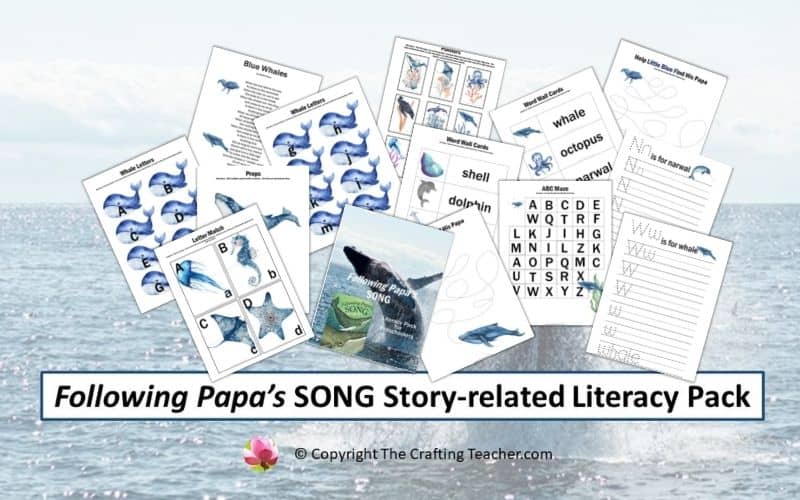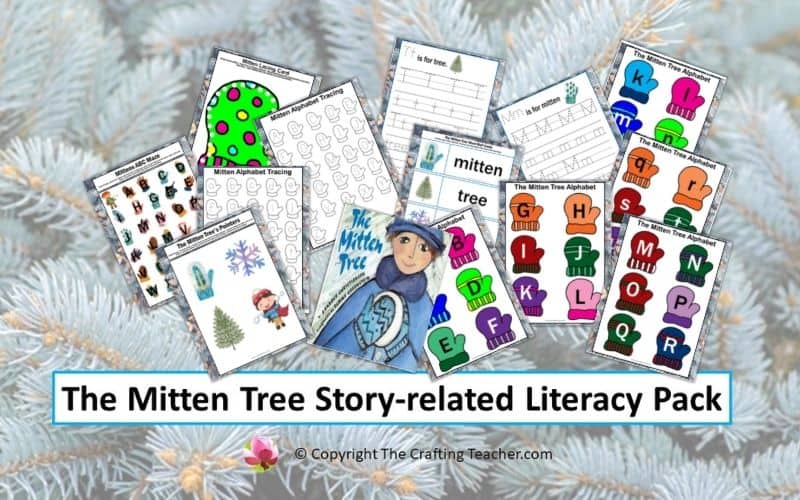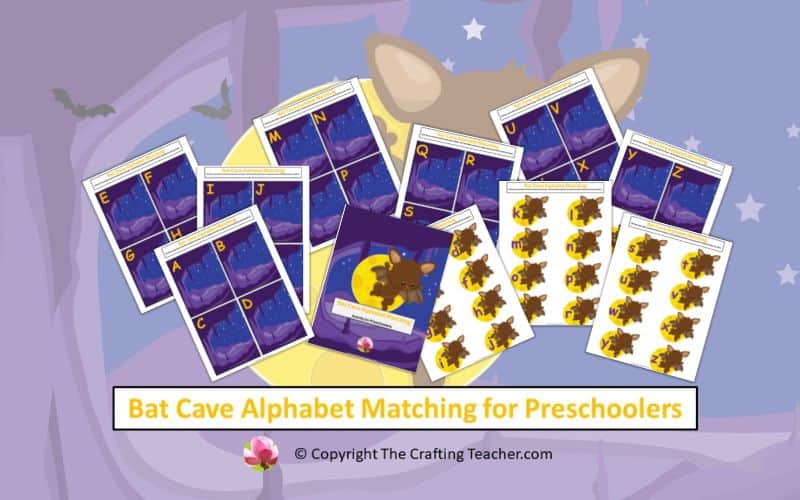Down by the Cool of the Pool Story-related Literacy Pack for Preschoolers
Affiliate Disclosure: “This post contains affiliate links, which means I receive a small commission, at no extra cost to you, if you make a purchase using those links.”
Preschoolers will enjoy working on their literacy skills and learning about these fun animals, while doing hands-on easy-to-prep activities in the classroom, at home, or to complement your curriculum and/or lesson plans.
This supper fun story talks about a little frog that decided to dance by the pond and invite other farm animals to join her. The duck, the pig, the sheep, the cat, the dog, the goat, the pony, the donkey, and the cow decided to come and dance as well until one of them tripped and the entire dance party fell inside the pond, where they decided to keep on enjoying the cool of the pond.
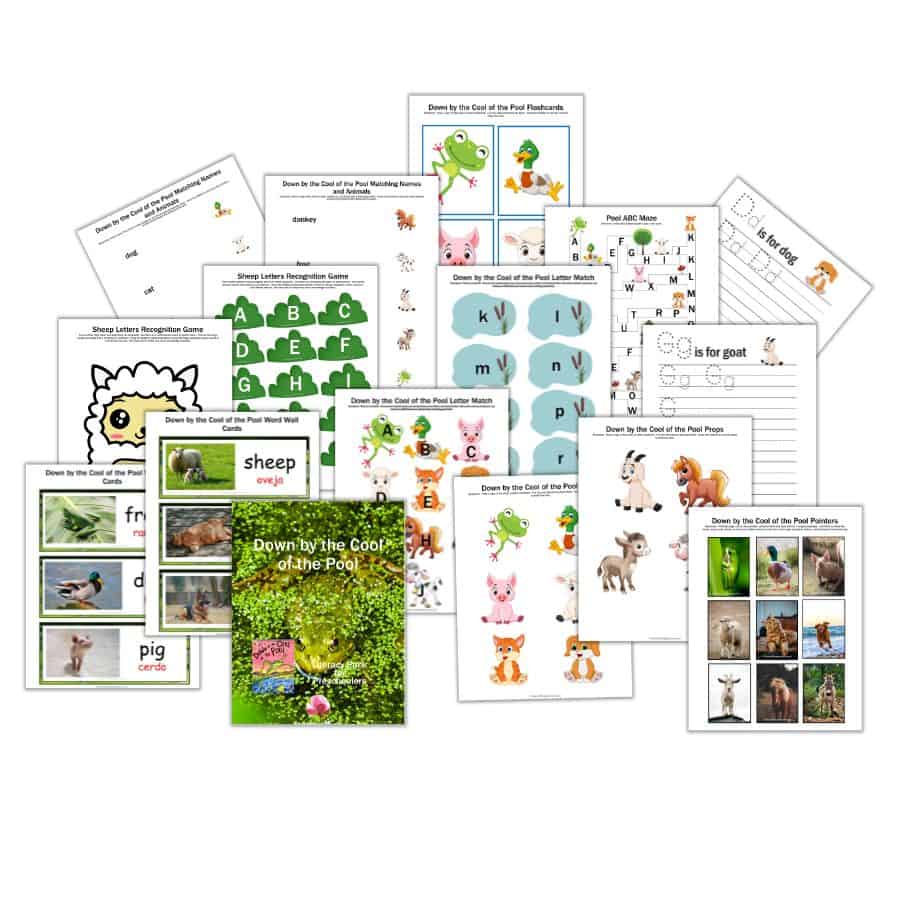
I’ve created a FREE 38-page long Down by the Cool of the Pool Literacy Pack for this story with nine different activity sets, which includes vocabulary words, letter tracing, letter find, alphabet matching, and other activities that will allow you to take full advantage of this fun story, whether you are a teacher or a parent. You can download it at the end of this post.
Down by the Cool of the Pool Literacy Pack
Start by showing them the pictures in the book without reading. Use the opportunity to ask questions and let them comment about what they see. Then read the story.
When I read a book, I like to use pointers to mark the words as I’m reading. That is an easy and very efficient way to show preschoolers that you read from left to right and top to bottom and that words have meaning.
The Down by the Cool of the Pool Literacy Pack includes ten pointers, one for each of the animals that appear in the story with real pictures, for you to use with this book. You just have to print them in white cardstock, cut them out, laminate them, and glue them to a tongue depressor. Use them to follow the word while reading the story. That will show your preschoolers that you read from left to right and top to bottom.
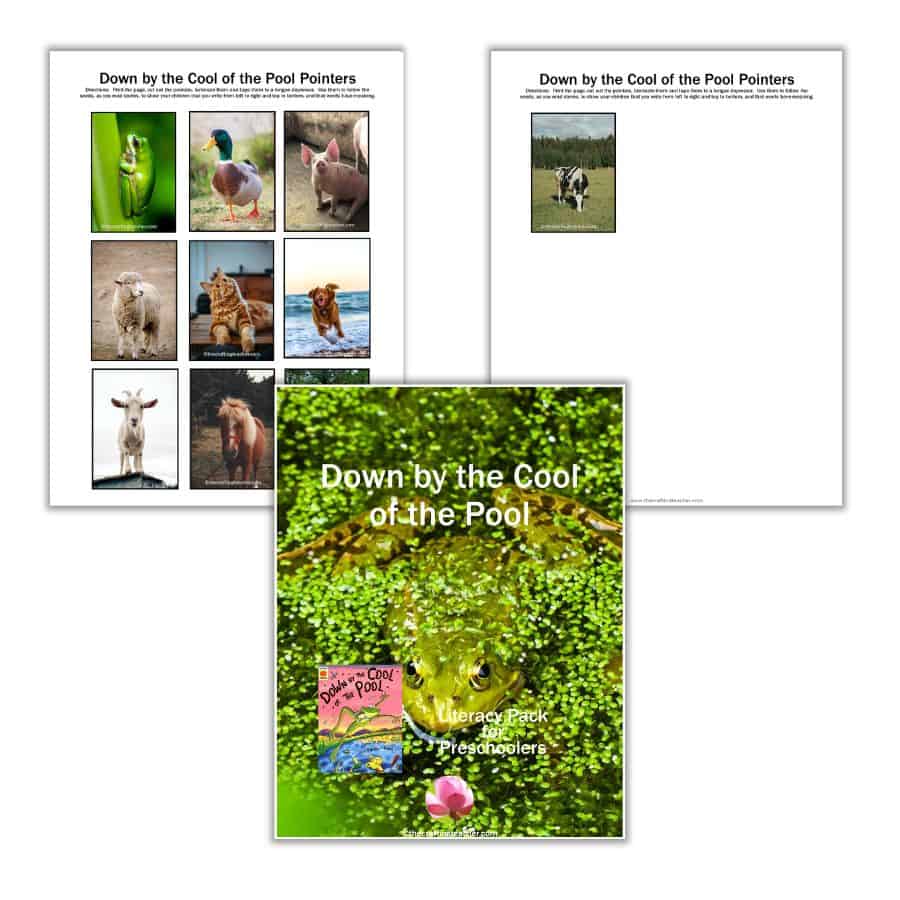
Literacy
The development of literacy skills includes awareness of books and prints, knowing the relationships between letters and sounds that makeup words, vocabulary development, and understanding stories. It is a process that starts from the very beginning of a child’s life, and it is the base for his or her future language development and the ability to read, write, and overall learn. If a child cannot read, it will be impossible for him or her to learn important concepts such as Math and Science, and understand the world around him or her.
Reading Aloud and Emergent Comprehension
There are several activities you can do to help your preschoolers develop these abilities. Below are some ideas.
Questions About The Story
Before reading review the parts of the book: cover, title, author, illustrator, spine, and back. Show them the cover and talk about the type of animals they see in the story. Tell them they are farm animals.
During reading ask who, what, where, when, and why questions, such as:
- Who are the main characters of the story?
- Where is the story taking place?
- Pointing at an animal, ask: What sound this animal makes?
Also, ask open-ended questions. Open-ended questions are the ones that can have multiple answers, such as questions about the student’s life experiences.
After reading ask questions about the story, such as:
- Do you think the animals are enjoying the dance? Why?
- Have you seen any of these animals? Where?
- Which of these animals can be a good pet? Why?
- What do you think will happen next?
Retelling The Story
Gather the children in a circle on the floor. Place a blue sheet of paper in the middle of the circle, and tell them that it represents the pond.
Print several copies of the props provided in the The Down by the Cool of the Pool Literacy Pack using white cardstock. Cut them out and laminate them. Distribute the story props among the students and encourage them to retell the story using their props. They should make the props dance to act out the story. When the activity is complete, place the props in the Listening or Library Center, to invite the children to retell the story on their own.
Oral Language and Vocabulary Development
If you use a Word Wall, print out the words provided in the pack using white cardstock, cut them out, and laminate them, to teach them to your students. I’ve included in the Down by the Cool of the Pool Literacy Pack ten Word Wall Cards in English and Spanish, with the animals that appear in the story. After you present each of the cards, encourage your children to use each Word Wall word in a short sentence or talk about the animal they see in each of them. This practice will help them with their vocabulary development and conversation skills.
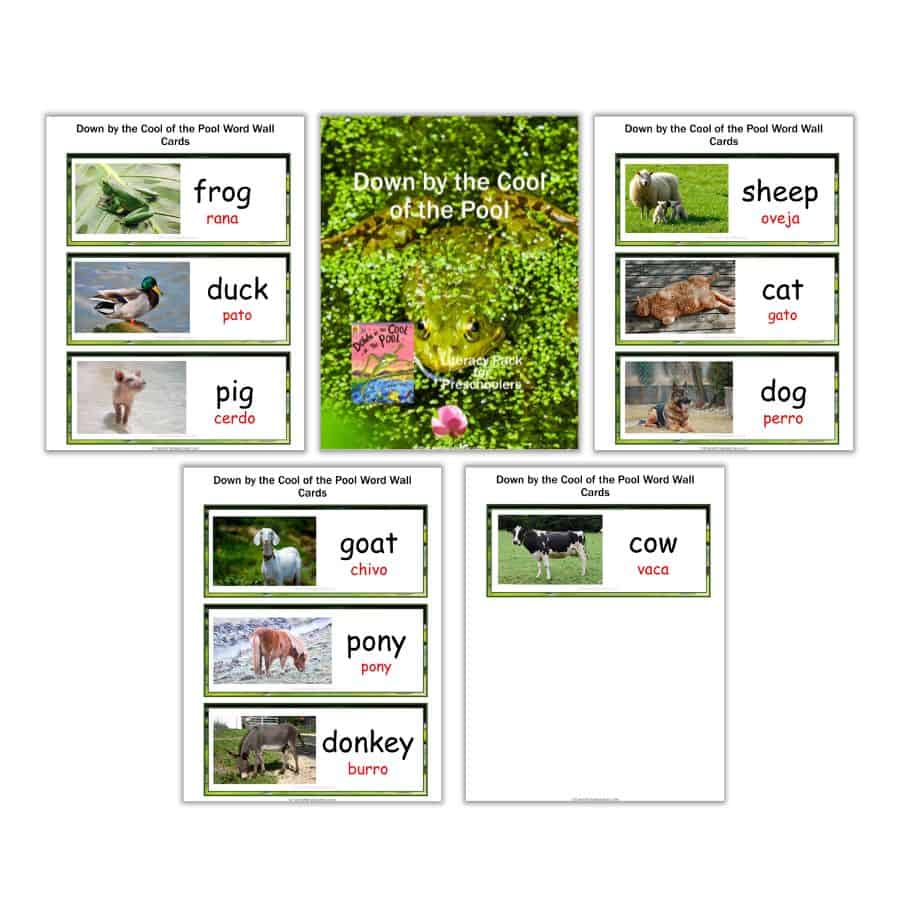
Reading Along
It is always good to invite the children to follow along with the story while listening to a recording. If you don’t have a recording of Down by the Cool of the Pool, you can always use YouTube for that. Here is a direct link for you to use.
Letter Name and Sound Knowledge
It is important that children learn the names of the letters and then the sounds that each letter makes. This will set the foundation to be able to put the phonemes together to form syllables and then words later on.
To practice their letter knowledge, I created three different activities, which are included in the Down by the Cool of the Pool Literacy Pack. These are:
Letter Match
This cute activity includes all the letters of the alphabet. It comes with animal uppercase letters, and ponds with matching lowercase letters. Print them all out in white cardstock, cut them out, and laminate them to make them last longer. Invite the children to select an animal letter, say the name of the letter name or sound, or both (according to the child’s level), and place it on top of the matching pond letter.
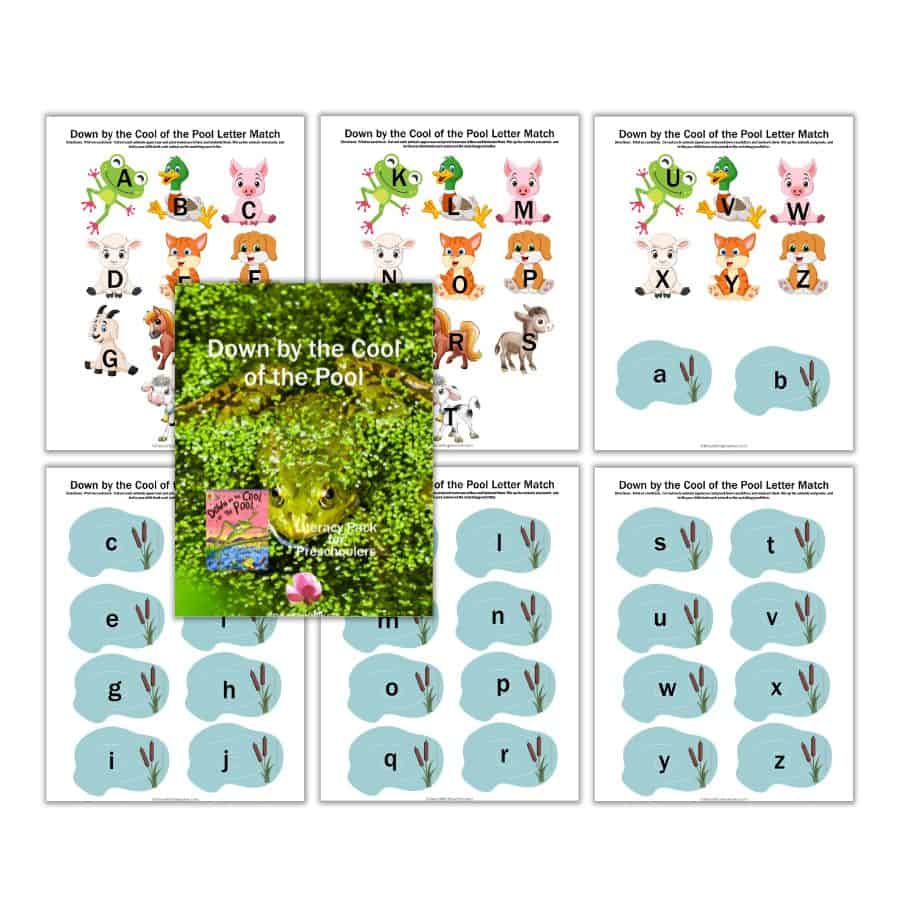
Sheep Letter Recognition Game
Print out the sheep’s face and letter grass in a white cardstock and cut out its mouth. Laminate it to make it last longer, cut out the interior of the mouth, and glue it on a square tissue box (make sure you cut out the hole for the mouth in the box as well). Then invite your students to select a grass letter to feed the sheep, say the letter name or sound or both (according to the child’s level), and push the grass inside the sheep’s mouth.
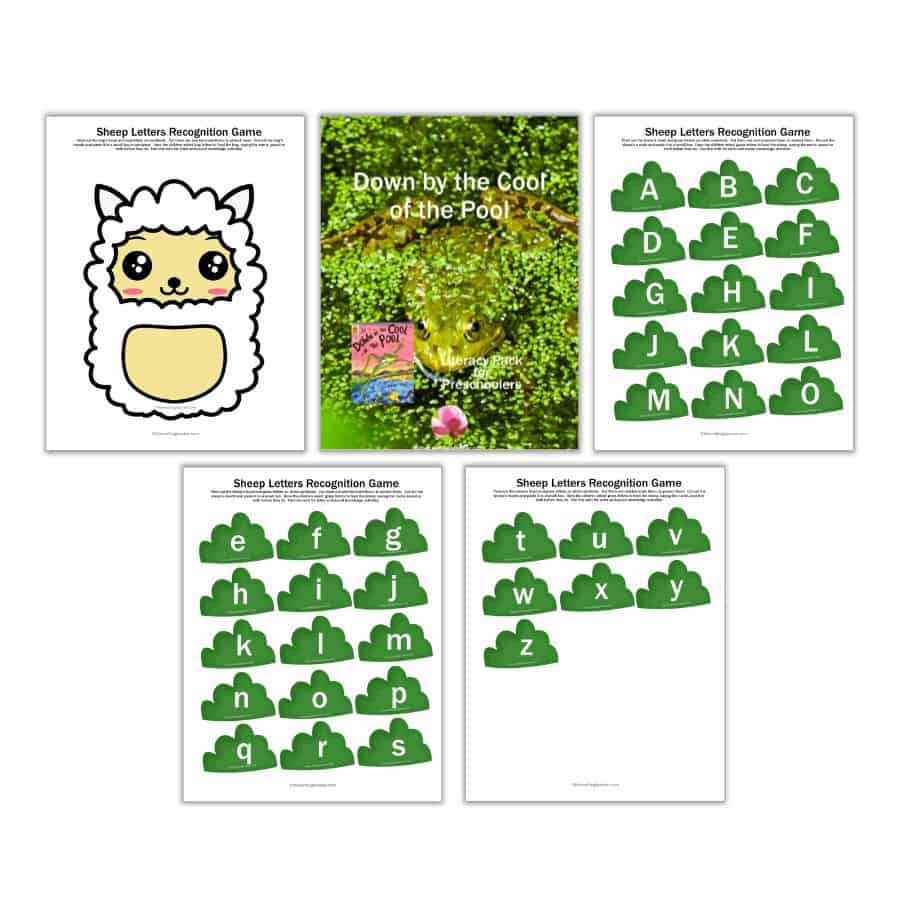
Pond ABC Maze
Review the letter’s name and sound. Invite the children to say a word that starts with each of the letters. Sing the alphabet song and then have your preschoolers review the alphabet by using a dot-to-dot marker to mark each letter of the alphabet in the correct order. Encourage them to say the name of the letters and/or the sound as they go.
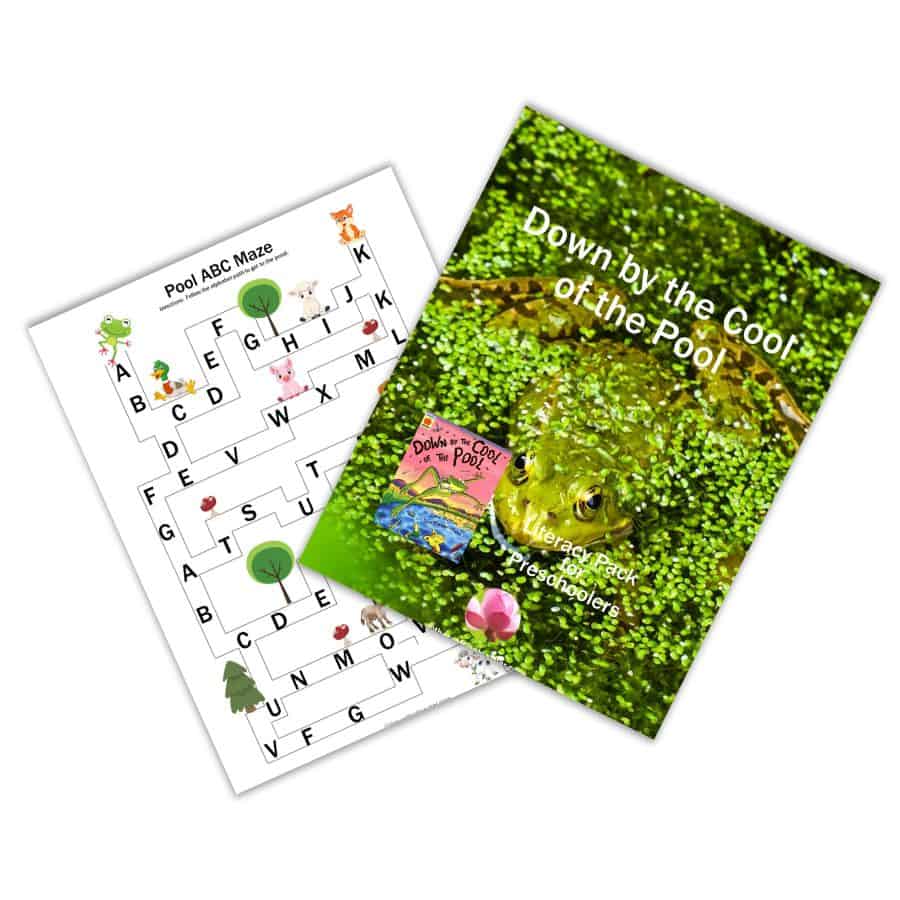
Phonological Awareness and Phonics
Remind your students that words are made up of individual letters. Say one of the vocabulary words, then spell it using your Word Wall Cards. Ask the children to wiggle every time you say a letter.
Pond Blends
Remind your children that by blending the sounds they can make words. Call out the vocabulary words, one phoneme at a time, and ask the students to practice blending the sounds to form the words.
For example:
- frog – /f/ /r/ /o/ /g/
- duck – /d/ /u/ /c/ /k/
- pig – /p/ /i/ /g/
- sheep – /s/ /h/ /e/ /e/ /p/
- cat – /c/ /a/ /t/
- dog – /d/ /o/ /g/
- goat – /g/ /o/ /a/ /t/
- pony – /p/ /o/ /n/ /y/
- donkey – /d/ /o/ /n/ /k/ /e/ /y/
- cow – /c/ /o/ /w/
Emergent Writing
There are many activities you can do to help your preschoolers develop their fine motor skills and pencil grasp such as cutting, pasting, coloring, sculpting with playdough, ripping, and tracing.
Tracing Letters and Words
The Down by the Cool of the Pool Literacy Pack includes ten tracing letters and word sheets, one for each of the animals that appear in the story. Print each page using white cardstock, cut them out, and laminate them or place them in dry-erase pockets to make them last longer, and use them multiple times. Invite the children to use a dry-erase marker to trace the letters and words.
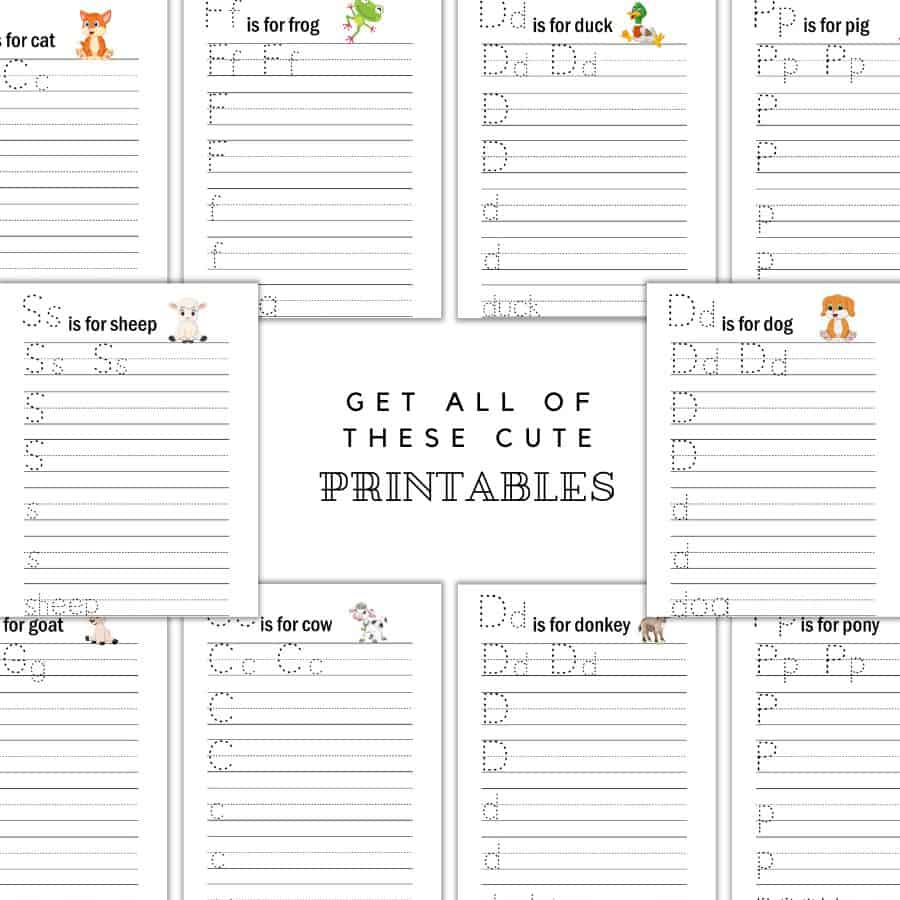
This activity is great for strengthening the children’s language, letter recognition, pre-writing, and fine motor skills. To extend the activity you can use these pages to do other activities. Below are some ideas:
- Teach or review letters’ sounds and names.
- Spell the words.
- Match each letter and word with magnetic, foam, or wooden letters.
- Copy the letters and words with pencils, crayons, or markers.
Write a Class Story to Make a Book
During circle time invite your children to create a story, reminding them that the story has to have a beginning, middle, and end. Use chart paper to take dictation.
You can encourage them by starting with something like “When I visit a pond (lake, river or ocean) one day….”.
When the story is finished, print it out and have the students illustrate the story. Put it together as a book for the library, and make a copy for each of the authors.
Language Development
Young children must develop their language and learn how to express their ideas. That is why it is so important that teachers and parents talk to the children all the time, asking questions, and having conversations, no matter how simple or silly they may be. This is a great way to help preschoolers develop these skills is by using a storybook.
Discussion About the Story
After working with the story, ask your preschoolers what they think about it. Use the example of the animals playing together, and ask them if it is easy for them to play with their friends.
Discuss the ending of the story and their opinion about it. Ask them if that happened to them before. Invite them to imagine a different ending for the story. Write down the children’s opinions on chart paper.
Show them the flashcards I’ve included in the Down by the Cool of the Pool Literacy Pack. Ask them if they remember which animal appears first in the story. Ask them if they remember what action that animal was doing (frog–danced). Invite them to name the right action and demonstrate it. Then ask them which animal came first and what action that animal did (duck–flapped). Ask the children to demonstrate again. Continue until they mentioned all the animals in the story and the action they did (pig – wiggled; sheep – stomp; cat – sprang; dog – frisked; goat – butted; pony – pranced; donkey – drummed; cow – capered).
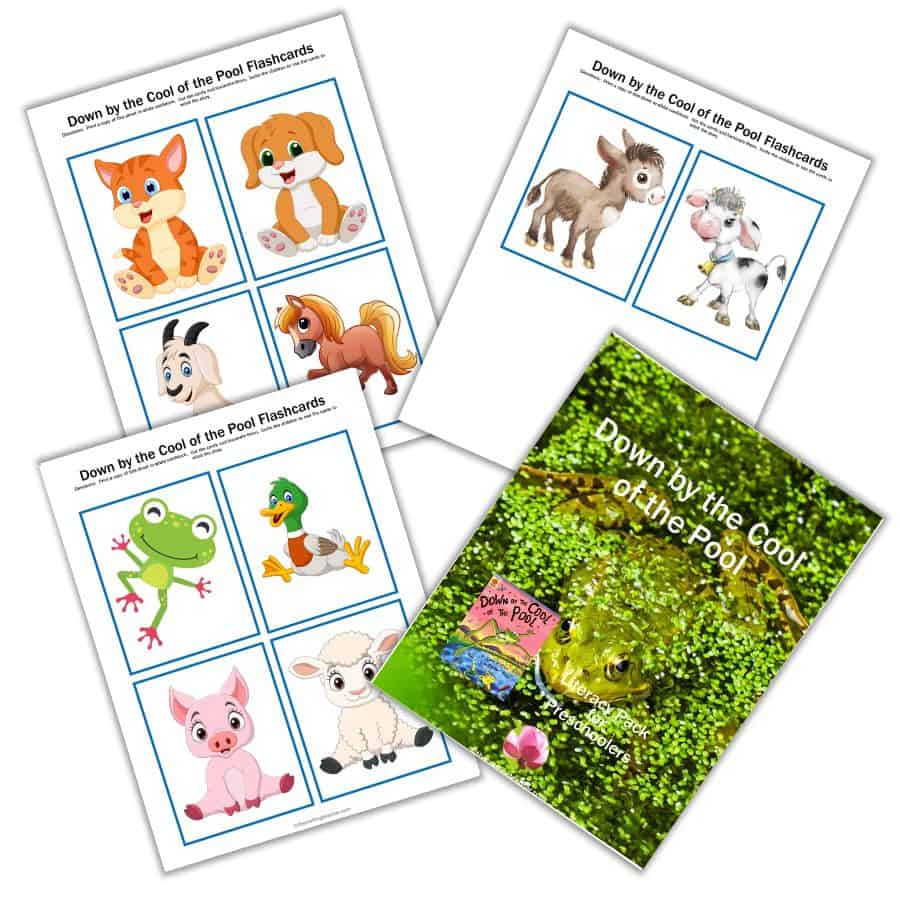
Emergent Reading
For preschoolers who are a little more advanced and starting to read, have them match the animals with their names. To do this, just print the provided sheets in white cardstock, laminate them for durability, and have the children match each animal with its name using a dry-erase marker. I will suggest printing multiple copies, so several children can do the activity at the same time.

Other Related Books
You can always read and add more books about farm life and animals to your library and other centers, to give children a wide learning experience and variety to choose from. I’m sure the previous activities will spice their curiosity, and these books could be an excellent source of knowledge.
Below are some you can use. You can find them at your local library, used book store, and on Amazon. For your convenience, I added my Amazon links to the titles, so you can go directly to the site if you want to purchase one.
- National Geographic Readers: Farm Animals by Joanne Mattern. This book will help children learn all about adorable farm animals.
- My Farm Friends by Wendell Minor. This book is a perfect introduction to our farm friends, using bold artwork and jaunty verse.
- On the Farm by Little Hippo Books. This book illustrates life at the farm, including all the classic farm animals, cows, horses, pigs, and sheep.
- Modern Farms by Jackie Nix. This nonfiction book introduces children to farm life, using rhyming verse and bright, attention-getting illustrations, to teach about the many different types of farms, from row crops to fruits and vegetables, to farm animals.
- Tractors Found on the Farm by Wordplay Groundhog. Using cute rhymes and farm illustrations, this fun storybook uses simple sentences and silly tractor pictures that include farm animals, barns, and classic agriculture scenery.
- This Book is a Farm by Lenna Grey. Kids will love becoming part of the story as they tackle interactive farm chores.
- Cows Can Moo! Can You? All About Farms by Bonnie Worth. Ideal for kids who love animals and machines, this is a perfect choice for families making their first visit to a farm or petting zoo, or for explaining where food comes from.
- Amara’s Farm by Ja-Nay Brown Wood. The playful text guides young readers to hunt for visual clues and compare and contrast the unique characteristics of pumpkins against okra, cauliflower, eggplant, and other produce that grows on Amara’s farm.
- The Busy Little Tractor by Little Hippo Books. This is a great story about friendship and helping each other.
- Barn in Winter: Safe and Warm on the Farm by Chambrae Griffith. Celebrate winter with this beautiful keepsake book lyrically written in rhyming verse with gorgeously rich illustrations.
- Counting Animals on the Farm by Goodzilla Books. A perfect book for little students learning to count from 1 to 10 fun and easy, with our animals.
- Mrs. Wishy-Washy’s Farm by Joy Cowley. This funny story talks about Duck, Cow, and Pig running away from Mrs. Wishy-Washy to the big city, where they get lost, wander into a restaurant, and even stumble into a hardware store and get covered in paint!
Pin It For Later
If you are in a rush and don’t have time to read the post and download the printable but want to save it for later, pin it to one of your Pinterest boards.
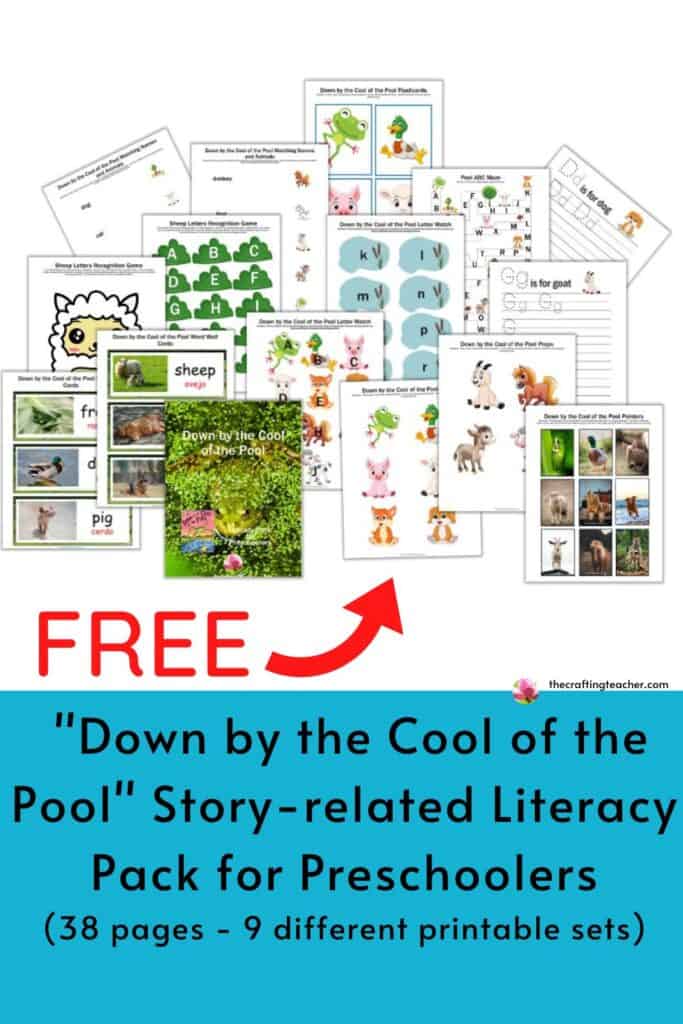
You can use the Down by the Cool of the PoolLiteracy pack by itself, or you can combine it with the math and science packs I’ve created for the same story, which include free printables as well.
I hope you enjoy these ideas and help your preschoolers develop their literacy skills even further, with this fun story. To get the FREE Down by the Cool of the Pool Literacy Pack, just click on the link below and put your information, for an immediate download.
Be happy, safe, and creative. I wish you well.
Love,

P.D. Please let me know if you like any of these ideas worked for you, or if you think I need to add or replace something. My goal is to help you in any way I can and I don’t like anything better than to post something that you might find useful. Also, if you come up with different ideas and want to share them, I would love to post them as well.


